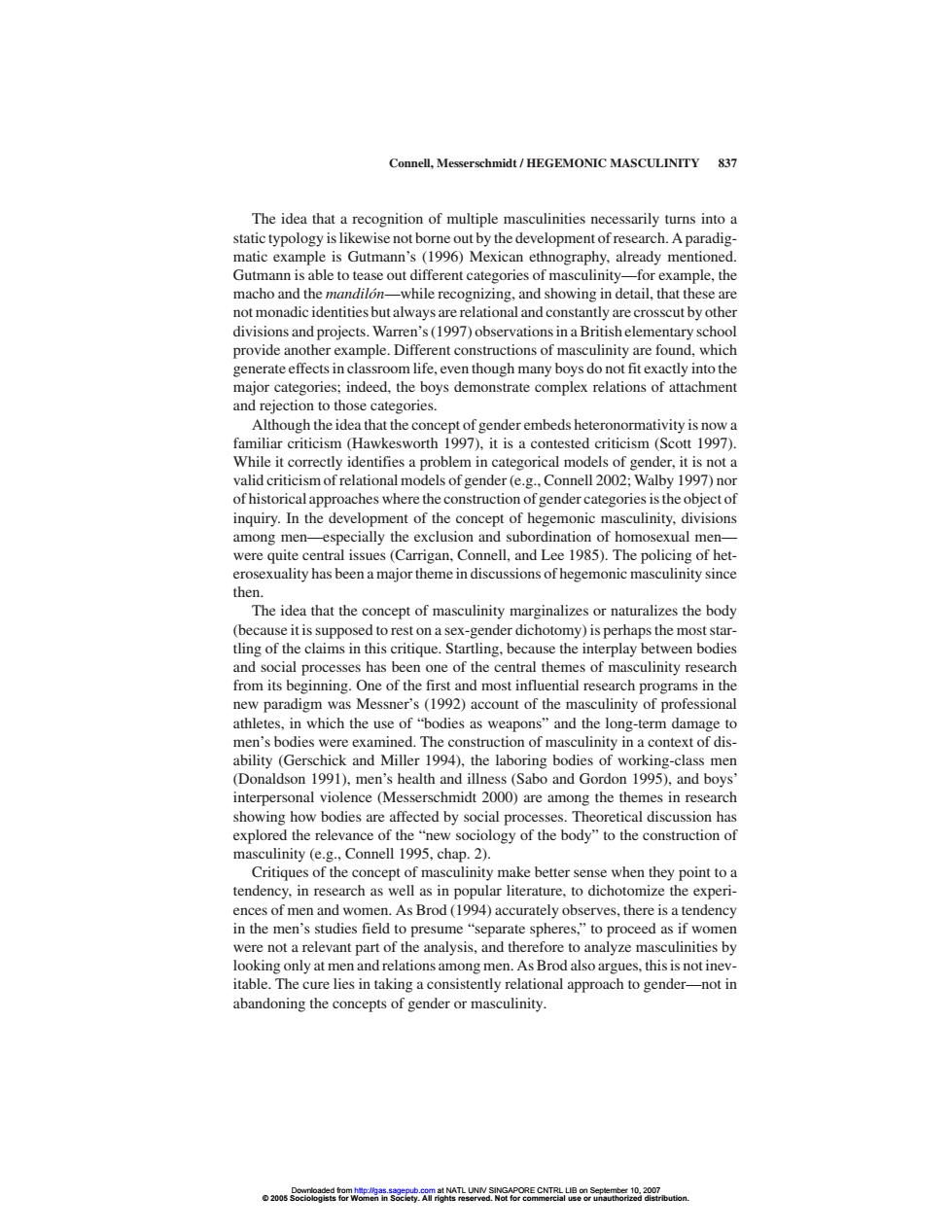正在加载图片...

Connell,Messerschmidt/HEGEMONIC MASCULINITY 837 The idea that a recognition of multiple masculinities necessarily turns into a static typology is likewise not borne out by the development of research.A paradig- matic example is Gutmann's(1996)Mexican ethnography,already mentioned. Gutmann is able to tease out different categories of masculinity-for example,the macho and the mandilon-while recognizing,and showing in detail,that these are not monadic identities but always are relational and constantly are crosscut by other divisions and projects.Warren's(1997)observations in a Britishelementary school provide another example.Different constructions of masculinity are found.which generate effects in classroom life,even though many boys do not fit exactly into the major categories;indeed,the boys demonstrate complex relations of attachment and rejection to those categories. Although the idea that the concept of gender embeds heteronormativity is now a familiar criticism (Hawkesworth 1997).it is a contested criticism (Scott 1997). While it correctly identifies a problem in categorical models of gender,it is not a valid criticism of relational models of gender(e.g.,Connell 2002;Walby 1997)nor of historical approaches where the construction of gender categories is the object of inquiry.In the development of the concept of hegemonic masculinity,divisions among men-especially the exclusion and subordination of homosexual men- were quite central issues(Carrigan,Connell,and Lee 1985).The policing of het- erosexuality has been a major theme in discussions of hegemonic masculinity since then. The idea that the concept of masculinity marginalizes or naturalizes the body (because it is supposed to rest on a sex-gender dichotomy)is perhaps the most star- tling of the claims in this critique.Startling,because the interplay between bodies and social processes has been one of the central themes of masculinity research from its beginning.One of the first and most influential research programs in the new paradigm was Messner's(1992)account of the masculinity of professional athletes,in which the use of"bodies as weapons"and the long-term damage to men's bodies were examined.The construction of masculinity in a context of dis- ability (Gerschick and Miller 1994),the laboring bodies of working-class men (Donaldson 1991),men's health and illness(Sabo and Gordon 1995),and boys' interpersonal violence (Messerschmidt 2000)are among the themes in research showing how bodies are affected by social processes.Theoretical discussion has explored the relevance of the"new sociology of the body"to the construction of masculinity (e.g.,Connell 1995,chap.2). Critiques of the concept of masculinity make better sense when they point to a tendency,in research as well as in popular literature,to dichotomize the experi- ences of men and women.As Brod(1994)accurately observes,there is a tendency in the men's studies field to presume"separate spheres,"to proceed as if women were not a relevant part of the analysis,and therefore to analyze masculinities by looking only at men and relations among men.As Brod also argues,this is not inev- itable.The cure lies in taking a consistently relational approach to gender-not in abandoning the concepts of gender or masculinity. o2oosS6e08a8rmh8Pg532RT4T60N66O2ECTBgartto1827butionThe idea that a recognition of multiple masculinities necessarily turns into a static typology is likewise not borne out by the development of research. A paradigmatic example is Gutmann’s (1996) Mexican ethnography, already mentioned. Gutmann is able to tease out different categories of masculinity—for example, the macho and the mandilón—while recognizing, and showing in detail, that these are not monadic identities but always are relational and constantly are crosscut by other divisions and projects. Warren’s (1997) observations in a British elementary school provide another example. Different constructions of masculinity are found, which generate effects in classroom life, even though many boys do not fit exactly into the major categories; indeed, the boys demonstrate complex relations of attachment and rejection to those categories. Although the idea that the concept of gender embeds heteronormativity is now a familiar criticism (Hawkesworth 1997), it is a contested criticism (Scott 1997). While it correctly identifies a problem in categorical models of gender, it is not a valid criticism of relational models of gender (e.g., Connell 2002; Walby 1997) nor of historical approaches where the construction of gender categories is the object of inquiry. In the development of the concept of hegemonic masculinity, divisions among men—especially the exclusion and subordination of homosexual men— were quite central issues (Carrigan, Connell, and Lee 1985). The policing of heterosexuality has been a major theme in discussions of hegemonic masculinity since then. The idea that the concept of masculinity marginalizes or naturalizes the body (because it is supposed to rest on a sex-gender dichotomy) is perhaps the most startling of the claims in this critique. Startling, because the interplay between bodies and social processes has been one of the central themes of masculinity research from its beginning. One of the first and most influential research programs in the new paradigm was Messner’s (1992) account of the masculinity of professional athletes, in which the use of “bodies as weapons” and the long-term damage to men’s bodies were examined. The construction of masculinity in a context of disability (Gerschick and Miller 1994), the laboring bodies of working-class men (Donaldson 1991), men’s health and illness (Sabo and Gordon 1995), and boys’ interpersonal violence (Messerschmidt 2000) are among the themes in research showing how bodies are affected by social processes. Theoretical discussion has explored the relevance of the “new sociology of the body” to the construction of masculinity (e.g., Connell 1995, chap. 2). Critiques of the concept of masculinity make better sense when they point to a tendency, in research as well as in popular literature, to dichotomize the experiences of men and women. As Brod (1994) accurately observes, there is a tendency in the men’s studies field to presume “separate spheres,” to proceed as if women were not a relevant part of the analysis, and therefore to analyze masculinities by looking only at men and relations among men. As Brod also argues, this is not inevitable. The cure lies in taking a consistently relational approach to gender—not in abandoning the concepts of gender or masculinity. Connell, Messerschmidt / HEGEMONIC MASCULINITY 837 © 2005 Sociologists for Women in Society. All rights reserved. Not for commercial use or unauthorized distribution. Downloaded from http://gas.sagepub.com at NATL UNIV SINGAPORE CNTRL LIB on September 10, 2007